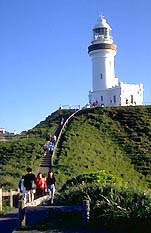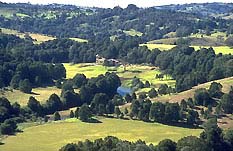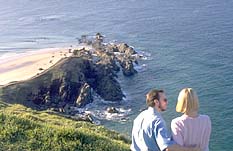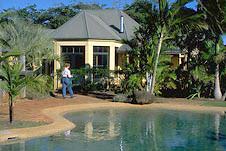
|
| The Byron Bay lighthouse
|
Byron Bay
Hugely popular destination on the North Coast which has
attracted by alternative lifestylers and wealthy refugees
from city living.
There can be few towns in Australia with a more
contradictory identity than Byron Bay. On one hand it has,
historically, been associated with the alternative lifestyle
movement of the 1970s and seen as a kind of interesting
hippie retreat in northern NSW. On another level it has been
seen as a very upmarket get-away-from-it-all retreat for
wealthy southerners not wanting to mix with the hoi polloi
who inhabit more vulgar coastal townships like Coolangatta
and Tweed Heads. And over the past twenty years it has
acquired a reputation as the residence of the rich and
famous with Paul Hogan and Linda Kozlowski moving into a
mansion in the hinterland (which they have subsequently
left), John Cornell and Delvene Delaney doing the same and
owning a local hotel, and the likes of Olivia Newton-John
finding the place an ideal retreat from their LA lifestyle.
She, too, has moved on.
Recently the writer Craig McGregor argued that it was
really like the Californian coastal towns of Carmel and
Monterey in its evolution moving from surfers to artists,
tourists and celebrities.
The truth, if it can ever be gleaned from these rather
exaggerated images, is that for the most part, Byron Bay is
a quiet, pleasant little seaside town in northern New South
Wales. Certainly this is not a town like
Nimbin. Nor is it an overtly upmarket retreat like Noosa
Heads. It is just another ordinary country town which has
experienced a population boom because it boasts excellent
surfing and plenty of good land. Without the publicity few
people would drive off the Pacific Highway and only holiday
makers would decide to stay.
The overwhelming impression is that it is a town hiding
behind Cape Byron and nestled in between the rocky headland
and the hills which rise to the west. In the past five years
it has grown dramatically and now spreads in every direction
- both up and down the coast and well into the hinterland.
One of the things that makes it special, as Craig
McGregor observed, is that 'Public pressure has halted both
Club Med and McDonald's from moving in; the green-dominated
Byron Shire Council has banned drive-in takeaway food
outlets from the town centre; buildings have been restricted
to three storeys in height; and a moratorium has been placed
on high-density development until the sewerage facilities
catch up.' In those actions lie the heart of contemporary
Byron Bay. It is different.
Byron Bay is located 790 km north of Sydney and 173 km
south of Brisbane. It has the distinction of being one of
the many places along the east coast of Australia which was
named by Captain James Cook as he sailed up the coast in
1770.
Writing in his ship's log on 15 May 1770 Cook recorded "I
named Cape Byron ... a tolerable high point of land, bore
north west, distant three miles. It may be known by a
remarkable high peaked mountain lying inland north-west by
west from it. Inland it is pretty high and hilly, but near
the shore it is low; to the southward of the point the land
is low, and tolerable level...'
Cook named the 'high point' Cape Byron after Vice-Admiral
John Byron who was the grandfather of the famous 19th
century poet, Lord Byron.
It is possible that Cook's vessel was observed by the
traditional owners, the Banjalang Aboriginal people, who
knew the area as 'cavaba' (in an early map this was spelt
'cavvanba' and, for a brief time, it was known as
'Cavanbah') which some claim means 'meeting place'.
European development of the area was typical of all the
New South Wales north coast. In 1828 Captain H.J. Rous took
soundings and named the bay to the north of the cape, Byron
Bay. By the 1840s cedar cutters, eager to cut down the
timber, had moved into the area. They continued to be active
in the hinterland until the 1850s. The area around the Bay
remained uninhabited by Europeans until 1869. It was around
this time that settlers started to move into the area.
Little development occurred until 1869 when the whole
district was subdivided. Again development was slow. The
earliest settler in the district were Thomas Skelton who
purchased land in the district in 1881. By 1886 Eli Hayter,
another settler who arrived in 1881, had opened a butcher's
shop. It was at this time that work started on the town's
first jetty.
Through the 1880s the district was developed by the early
settlers who cleared the land and, to their delight, found
that the rich soils were capable of growing virtually
anything. By 1890 crops of bananas, pineapples, corn,
potatoes, all manner of vegetables and herds of horses and
cattle were common throughout the valley.
By 1886 the town of Byron Bay had become a reality. Town
lots were sold and general stores, hotels, blacksmith's
shops and a receiving office for mail were all built. Two
years later the jetty was completed and in that same year a
Post Office was established.
In 1890 the town got its first policeman and four years
later the name was officially changed from Cavanbah to Byron
Bay. This was also the year the railway arrived. In 1895 the
town's continuing existence was assured when Norco (an
abbreviation of North Coast Fresh Food and Cold Storage
Cooperative Ltd), a company producing a range of dairy and
meat products, opened a major factory. By 1925 it was the
largest butter producer in Australia.
The town's evolution was slow. As recently as 1938 there
were still only 1750 people living in Byron Bay and, over
the course of this century, it seems the major events have
been things like the establishment of the Cape Byron
lighthouse (1901), the building of the new Court House and
Police Station (1921), the arrival of electricity (1926),
the removal of the jetty (1947), the cessation of whaling
off the coast (1962) and the closing of the Norco Butter
factory (1975).

|
| Paul Hogan's mansion
(built after the success of Crocodile Dundee) in the
hills behind Byron Bay |
By the late 1980s the region had gone crazy largely as a
result of people like Paul Hogan, John Cornell, Elle
Macpherson, Peter Russell-Clarke, Olivia Newton-John and
Johnny Young all moving in. There were strange moments of
excess. Hogan spent nearly $4 million building his
quasi-Spanish mansion. John Cornell bought up 43 one acre
lots just so his rural outlook could be preserved and there
was talk of Cornell and Hogan spending $20 million to
develop the area. A local avocado farmer renamed himself
Fast Buck$ and tried to stop development and, strangely
enough, this seemed to work.
Today Byron Bay is sustained by tourism and its
associated industries. There are surfboard manufacturers in
town, good quality restaurants (Fins at the Byron Hotel is
one of the best restaurants in the country), a wide range of
diverse accommodation options (from tree houses to exclusive
bed and breakfasts) and the aim of any holiday is to relax
which is why there are really very few places to see and the
things to do tend to be more whale watching, surfing and
sunbathing.
The Byron Bay markets are held on the 1st Sunday of each
month and feature lots of produce from the surrounding area.
Things to see:

|
| A couple sitting on the
cliffs below the Byron Bay Lighthouse
|
Cape Byron Headland Reserve
Managed by the Cape Byron Trust as part of the National
Parks and Wildlife Service Estate, Cape Byron Headland
Reserve includes the lighthouse (see below) as well as a
number of excellent walking tracks.
The delightful Cape Byron Headland Reserve and Walking
Track which heads both north and south from the lighthouse.
The northerly walking track winds around the cliffs to the
most easterly point before dropping down to Little Wategos
and Wategos Beach and the southerly track heads down the
ridge towards Captain Cook's Lookout. Both offer exceptional
views of the Pacific Ocean and therefore, in May and from
August through to October, they are ideal for spotting the
humpback whales which migrate up and down the coast.
Byron Bay Lighthouse
Byron's greatest attraction is the outstanding Byron Bay
lighthouse. It is located only 300 metres south of
Australia's easternmost point, Cape Byron. The lighthouse,
which was completed in 1901 and stands 22 metres high (113
metres above sea level) is an ideal starting point for the
delightful Cape Byron Headland Reserve and Walking Track.
The lighthouse, one of the most powerful on the NSW coast
had a range of 42 km out to sea at a time when lighthouses
were vital for navigation. It was built of concrete blocks
which meant there was no need to quarry for sandstone in the
local area.
It is now possible to stay in the lightkeepers quarters.
Contact the Cape Byron Trust (02) 6685 8565.

|
| Ewingsdale - a
particularly attractive B&B destination just outside
of Byron Bay |
Byron's Beaches
Byron Bay has a range of great beaches which are designed to
cater for all needs. In the shire there is a total of 37 km
of sandy beaches. The patrolled beaches, best for those with
families or people who want the certainty of help if they
get in trouble, are Wategos, Main Beach, Broken Head and The
Pass.
For nudists there is a nude beach which has been
designated by Byron Council. It is located 500 metres west
of Belongil Creek and can be accessed by driving down Grays
Lane at Tyagarah.
Broken Head Nature Reserve
This 98-ha reserve offers a walk through lush rainforest to
secluded King's Beach, a popular fishing spot. It is located
4km south of Byron Bay and the walking trails offer
excellent views of the coastline against a backdrop of
rainforest. It is a sad comment on the area that there was a
time, before the arrival of Europeans, when the area between
Byron Bay and Lismore was all sub-tropical rainforest. Today
less than 0.4% of that area is left. Broken Head is one of
those remnants and contains such beauties as white booyong,
rosewood, red bean, yellow and red carabeen, bangalow palms,
maidens blush and brush box.

Broadwalk
Business Brokers
Broadwalk Business
Brokers specialise in General Businesses for Sale, Caravan Parks for
Sale, Motels for Sale, Management Rights & Resorts for Sale, Farms for
Sale, Hotels for sale,Commercial & Industrial Properties for Sale.
Phone:
1300 136 559
Email:
enquiries@broadwalkbusinessbrokers.com.au
AUSTRALIAN BUSINESSES FOR SALE
COFFS HARBOUR BUSINESS BROKERS
BROADWALK BUSINESS BROKERS
GOLD COAST BUSINESSES FOR SALE
BRISBANE BUSINESSES FOR SALE
SYDNEY BUSINESSES FOR SALE
CARAVAN PARKS FOR SALE
BUSINESSES FOR SALE
MOTELS
FOR SALE
HOTELS
FOR SALE
Disclaimer
We advise prospective purchasers that we take no
responsibility for the accuracy of any information in the business
provided by vendors or their professional advisers and that they should
make their own enquiries as to the accuracy of this information,
including obtaining independent legal and/or accounting advice
Byron Bay

